| HOME | EVENTS | PHOTOS | LINKS |
The Wheelmen are a (inter)national, non-profit organization dedicated to keeping alive the heritage of American cycling, promoting the restoration and riding of early cycles manufactured prior to 1918, and encouraging cycling as part of modern living. Members are intent on learning lost skills, retelling lost stories, researching and writing of the golden era of cycling.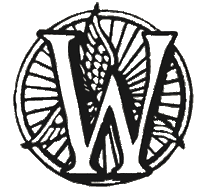 The Wheelmen embrace a broad range of bicycle-related activities, centered on the historical aspects of cycling. Such activities include riding in parades, tours and demonstrations, holding rides, participating in events to promote modern cycling, displaying bikes and memorabilia, research, writing and publishing cycle history, collecting bicycle literature and memorabilia, restoring cycles, restoring and recreating uniforms and costumes, recreating grand dance balls, picnics, developing buglers, show and tell meets, swap meets, auctions, slide shows, visiting historic sites and museums, and learning trick riding.
The Wheelmen embrace a broad range of bicycle-related activities, centered on the historical aspects of cycling. Such activities include riding in parades, tours and demonstrations, holding rides, participating in events to promote modern cycling, displaying bikes and memorabilia, research, writing and publishing cycle history, collecting bicycle literature and memorabilia, restoring cycles, restoring and recreating uniforms and costumes, recreating grand dance balls, picnics, developing buglers, show and tell meets, swap meets, auctions, slide shows, visiting historic sites and museums, and learning trick riding.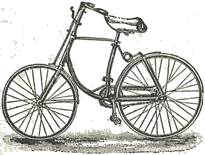 American Cushioned Rambler
American Cushioned Rambler
Each year the club has an Annual Meet, an activity where many Wheelmen worldwide join together in one city for a four-day celebration of antique cycling. For the first time, in the 45 years of the modern Wheelmen, the meet will be held in Louisville, KY, in June 2013.
Ten-mile tours, on bicycles manufactured prior to 1918, as well as twenty-five and one-hundred-mile (century) rides, bicycle games, uniform and costume judging, and bicycle judging. Ribbons, certificates and medals are presented at most meets for distance rides,games, races, uniform judging, and judging of bicycles for original or restored condition.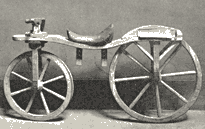
The club has established a constitution and by-laws, elected National Officers and State Captains, and appointed Committee Chairmen. In addition to the Annual Meet, there are many Wheelmen gatherings and activities throughout the year sponsored by the various State Divisions that include many of the fore mentioned activities and rides. Periodically, international tours are organized for Wheelmen to attend other gatherings sponsored by the International Veteran's Cycle Association.
The club caters to the needs of all aspects of cycle history, collectors, non-riders, and riders of high wheels, tricycles, tandems and safety bicycles.
Wheelmen membership is open to everyone worldwide, whether you own an antique bicycle or just enjoy the early days of our history when cycling was being born. Cycling history is an important part of our American heritage. Men, women and children of all ages are welcome to participate in our events throughout the year.
We invite you to join us in reviving and reliving the memories of the 1880’s and 1890’s – the great cycling era in America. Download The Wheelmen application form below and send it in.
Kentucky
Cycling Firsts
1880 – First ride of 100 miles in one day (century) by Orville Anderson and Henry
Schimpeler
1891 – First bicycle racetrack with electric lights
1894 – First Women’s road race
1894 – Fastest racetrack in America - Fountain Ferry Track
Kentucky Racers and Trick riders
1882 – Charles Jenkins world record holder for mile and quarter mile
1880s – Prince Wells Champion track rider and racer
1898 – “Ole Kaintuck” Owen Kimball 2 mile, quarter mile, mile Champion of America
 Carson Torpey in Bardtown, 2011
Carson Torpey in Bardtown, 2011
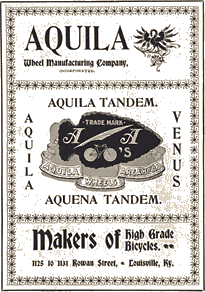
Louise Armaindo
1882 World Champion
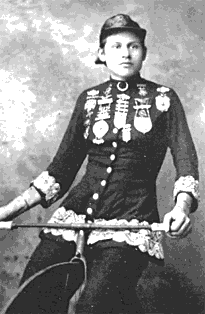 Louise Armaindo
Louise Armaindo Mlle. Louise Armaindo was born near Montreal, Canada, she was 5 feet 2 1/2 inches tall and weighed 135 pounds.
She defeated Prof. Fred Rollinson, the American champion, in three 20-mile races, Rollinson allowed her a 2 mile head start. At St. Louis, she rode 617.5 miles in 72 hours, 12 hours per day for six days. She won the race for the championship, and was willing to ride against any lady in America, or would take a five mile head start in a fifty mile race from any man in America.
Armaindo elevated an 80 lb. dumb bell, and could lift 700 lbs. dead weight, and was a natural athlete.
July 29, 1882 issue of "The National Police Gazette:New York."
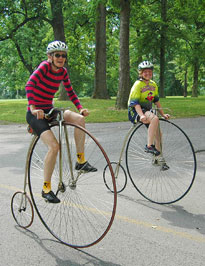 Racing at Shawnee - 2013
Racing at Shawnee - 2013
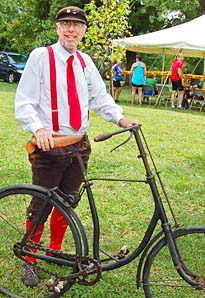 One of Carson’s many bikes
One of Carson’s many bikesThe Kentucky Wheelmen are a State Division of The Wheelmen, a national non-profit organization, dedicated to giving life to the history of cycling in Kentucky, and promoting the restoration and riding of antique bicycles. The Kentucky Wheelmen are learning lost skills and sharing forgotten stories about the gilded age of cycling.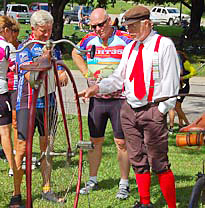 2013 Old Kentucky Home Tour
2013 Old Kentucky Home Tour
Basically, the KY Wheelmen engage in the same antique bicycle-related activities as the other divisions do, including educating those interested in the hobby by giving demonstations and exhibits of bikes and memorabilia, riding in parades, research writing, and publication of the commonwealth’s cycling history, plus, restoration of antique bicycles and equipment, and creating uniforms and costumes for public appearances.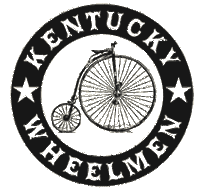
A Short History of Old Bicycles
1817 to 1819: Draisienne or Velocipede
Unverifiable claims of bicycle-like machines go back to the late 1490s, but it is known that in 1817 German Baron Karl von Drais, a civil servant to the Grand Duke of Baden in Germany, invented a “running machine”, in his interest to find an alternative to the horse.
Two same-size in-line wheels, the front one steerable, propelled by pushing the rider’s feet against the ground.
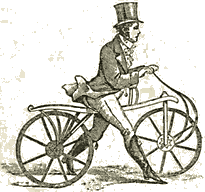 The Dandy Horse
The Dandy HorseMade mostly of wood, the draisine weighed almost 50 pounds, and had wheel bearings, iron shod wheels, and a rear brake. Thousands were built and became known as a Dandy Horse because of the style of men that rode them.
It was a velocipede that inspired a French metalworker around 1863 to add rotary cranks and pedals to the front-wheel hub, to create the first pedal-operated “bicycle” as we know them today.
1820s to 1850s: Era of 3 and 4-wheelers
Technically not part of 2-wheel “bicycle” history, the decades of the 1820s-1850s witnessed many developments concerning human-powered vehicles, often using technologies similar to the draisine, even if the idea of a workable 2-wheel design, requiring the rider to balance, had been dismissed.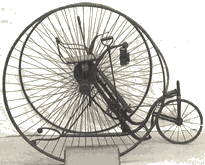 Starley Royal Salvo Tricycle
Starley Royal Salvo Tricycle
These machines had three wheels (tricycles) or four (quadracycles) and came in a wide variety of designs, using pedals, treadles and hand-cranks, but most of the designs suffered from high weight and high rolling resistance.
1830: Scottish inventions
The first mechanically propelled 2-wheel vehicle was believed to have been built by Kirkpatrick MacMillan, a Scottish blacksmith, in 1839.
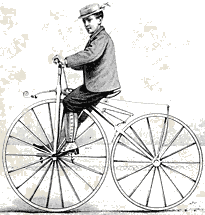
1860s: Boneshaker
The next appearance of a two-wheeled riding machine was in 1863, when pedals were applied directly to the front wheel.
This machine was known as the velocipede, but was popularly known as the bone shaker, since it was also made entirely of wood, then later with metal tires, and the combination of these with the cobblestone roads of the day made for an extremely uncomfortable ride.
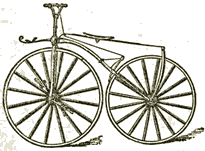 The Boneshaker
The Boneshaker
High-Wheel Racers
Women Attracted Crowds
In the late 1870s women’s bicycle racing was developing into a popular spectator sport.
In 1879, 18-year-old Lizzie Balmer covered eighteen and a half miles in two hours. At that time, women competed among themselves, and against male cyclists, pedestrians, and even trotting horses.
Though some denounced the ladies as common showgirls, there were in fact highly trained and motivated athletes.
 Elsa von Blumen
Elsa von BlumenIn 1881, Elsa von Blumen of Rochester, New York, rode a thousand miles during a six-day marathon in Pittsburgh, PA, although, toward the end, she had to be propped up on her bicycle and given stimulants.
Excerpts from the book "Bicycle: The History" by David V. Herlihy.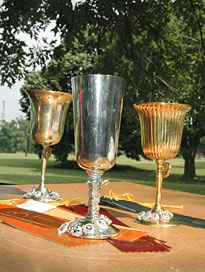 Racing Trophies - 2013
Racing Trophies - 2013
The National Meet in Louisville
Since the late 1960s the club has had an Annual Meet, an activity where Wheelmen worldwide come together in one place for a four-day celebration of antique cycling. The Wheelmen Meet was held in Louisville, KY, for the first time, in June, 2013.
 Wheelmen parade to the Culbertson Mansion in New Albany, IN
Wheelmen parade to the Culbertson Mansion in New Albany, IN
Friday, June 21, started with the “Distillery Run” ride, followed by a lecture on bicycle stamp collecting by Ed Muench, which was followed by an “Ice Cream Social” complete with live bluegrass music.
Saturday morning started out with the Swap Meet, then the Youth Cycle Corp practice, followed by the Executive Committee Meeting. The Wheelmen Meet historic group photo was taken at Central Park that afternoon, followed by the “Official High Wheel and Antique Safety Tour” and the “Retro Ride”. That evening Carson Torpey presented his “Louisville and the 1896 Meet” lecture.
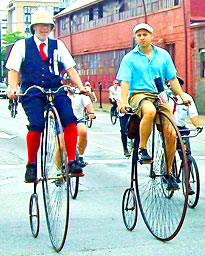 2013 Official High Wheel and Antique Safety Tour
2013 Official High Wheel and Antique Safety TourSunday was “Century Day”, as was the “New Albany Bicentennial Celebration”, a bicycle parade, and ice cream social, across the Ohio River in Indiana. “The New Woman: Annie ‘Londonderry’ Kopchovsky” video documentary was shown by Gillian Willman, the program’s producer and director. Later that evening was the “Light your Lamp” ride and stroll around St. James Court in Old Louisville.
Monday started with the Wheelmen General Meeting, followed by the “Interesting Life of Webster Gazlay” by Tim Meyer, lecturer. “Lost Photos: Allen & Sachtleben’s historic ride across Europe and Asia” lecture was presented by David Herlihy. The Wheelmen’s Bench Run out to Churchill Downs was followed by the Bicycle Games in the back lot of Cochran Elementary before the Belle of Louisville dinner cruise that evening.
Tuesday, June 25, concluded the 46th Annual Meet with the Fountain Ferry Ordinary Race for Two Half Hours at Shawnee Park.
New EventsHistory of Bicycles continued
1870s: High Wheel Bicycle
The first all metal machine appeared after metallurgy became advanced enough to create metal which was strong enough to make small, light-weight parts.
Pedals were attached directly to the front wheel, with no freewheeling mechanism. Solid rubber tires and the long spokes of the front wheel provided a smoother ride than its predecessor. The front wheels became larger because the larger the wheel, the farther you could travel with one rotation of the pedals. You would buy a wheel as large as your leg length would allow.
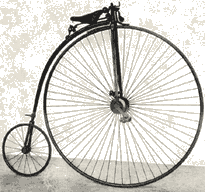 Penny Farthing
Penny Farthing
This machine was the first one to be called a bicycle (two wheel). These bicycles enjoyed a great popularity among young men of means since they cost an average worker six month’s pay. They were popular in the 1880s.
Because the rider sat so high above the center of gravity, if the front wheel was stopped by a stone or rut in the road, the entire apparatus rotated forward on its front axle, and the rider, with his legs trapped under the handlebars, was dropped unceremoniously on his head. Thus the term “taking a header” came into being.
 A Header
A Header
High Wheel Tricycle
While men were risking their necks on high wheels, ladies, confined to long skirts and corsets, would spin around the park on adult tricycles.
Many mechanical innovations now associated with the automobile were originally invented for tricycles. Rack and pinion steering, the differential, and band brakes, to name a few.
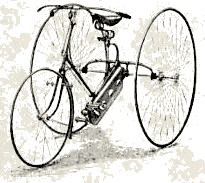 High Wheel Tricycle
High Wheel Tricycle
High Wheel Safety
Improvements to the design continued, many with the small wheel in the front to eliminate tipping-forward . They became known as high-wheel safety bicycles.
Since the older high-wheel designs had been known simply as bicycles, they became known as “ordinary bicycles”, in comparison with the new-fangled designs, or simply as “ordinaries.”
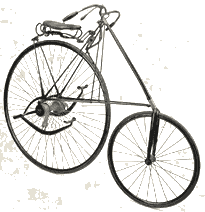 High Wheel Safety
High Wheel Safety
Ernestine Bernard
Raced Against Horses
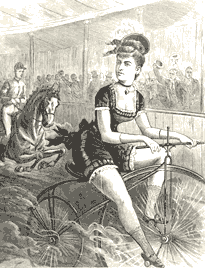 Ernestine Bernard
Ernestine Bernard Ernestine Bernard of Paris in the midst of a “hotly-contested three mile race with a noted running horse” at a rink in Toronto, Ontario, from the National Police Gazette, June 28, 1879. According to the journal, the victorious French athlete “appeared in scant garments appropriate to the occasion.”
Within a few years, female high-wheel racers gained a large following in North America.
Excerpts from the book "Bicycle: The History" by David V. Herlihy.Alison Torpey
KY Wheelmen
State Captain
Alison is a retired Systems Architect for Jefferson County Public Schools in Louisville, and is a native of Charlotte, Tennessee, She spent her childhood listening to old family stories, and watching her grandmother recycle every thing possible. In her mid-twenties she started riding bicycles, then met and married the person who her fixed her flat tires the fastest.
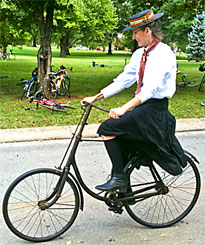 Alison riding an American Rambler
Alison riding an American Rambler
Alison is an avid collector of bicycles, stories, and photographs from the Glory Days of Cycling. She is the most active member of The Kentucky Wheelmen, while being State Captain of the Kentucky Wheelmen, and is also Secretary on the Board of the Original Highlands Neighborhood Association. Four cats share their 1884 Victorian home with Alison, her husband Carson, and their daughter. Carson owns Bardstown Road Bicycles, established April 1, 1994, and share the love of preservation of bicycle history.
The 2013 Wheelmen National Meet in Louisville was a huge success because of Alison’s incredible patience and attention to details.
Take a moment to introduce yourself and thank Alison when you see her. Being a state captain is a year around job of organization, one that few people could do so well.
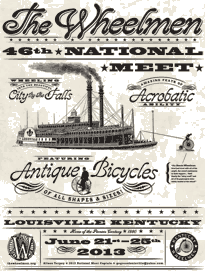
History of Bicycles continued
The Hard-Tired Safety
The further improvement of metallurgy sparked the next innovation, or rather return to previous design. With metal that was now strong enough to make a fine chain and sprocket small and light enough for a human being to power, the next design was a return to the original configuration of two same-size wheels, only now, instead of just one wheel circumference for every pedal turn, you could, through the gear ratios, have a speed the same as the huge high-wheel. Hard Tired Safety
Hard Tired Safety
The bicycles still had the hard rubber tires, and in the absence of the long, shock-absorbing spokes, the ride they provided was much more uncomfortable than any of the high-wheel designs. Many of these bicycles had front and/or rear suspensions.
The designs competed with each other, the choice being the high-wheel’s comfort or the safety’s safety, but the next innovation tolled the death of the high-wheel design.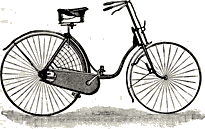 The Starley Safety Bicycle
The Starley Safety Bicycle
The Pneumatic-Tired Safety
The pneumatic tire (containing air under pressure) was invented for the bicycle by an Irish veterinarian. Dr. Dunlop wanted to invent a more comfortable ride for his son’s tricycle. Comfort and safety improved as cheaper manufacturing methods evolved, and everyone wanted to ride a bicycle.
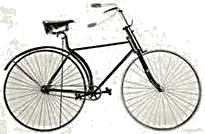 The Pneumatic Safety Bicycle
The Pneumatic Safety Bicycle
Bicycles made the Gay Ninties gay. It was a practical investment for the working man as transportation, and gave him a much greater flexibility for leisure.
Ladies, who had been riding the heavy adult size tricycles that were only practical for taking a spin in the park, now could ride a much more versatile machine and still keep their legs covered with long skirts. The bicycle craze killed the bustle and the corset, and instituted “common-sense dressing” for women and increased their mobility considerably.
 Annie Londonderry Kopchovsky
Annie Londonderry Kopchovsky
In 1896 Susan B. Anthony said that “the bicycle has done more for the emancipation of women than anything else in the world.”
Bicycling became so popular in the 1880s and 1890s that cyclists formed the League of American Wheelman, now known as the League of American Bicyclists.
The League lobbied for better roads, literally paving the road for the automobile.
Wheels of Change How Women Rode the Bicycle to Freedom, with a Few Flat Tires Along the Way
Learn more about how the bicycle revolutionized life well into the 1890s in Author Sue Macy's thrilling book on the subject of early cycling history and women.
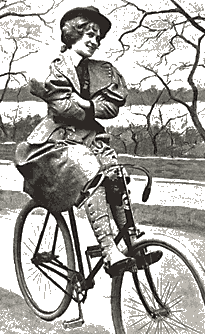 Elsa von Blumen from Wheels of Change by Sue Macy
Elsa von Blumen from Wheels of Change by Sue MacyMore Info
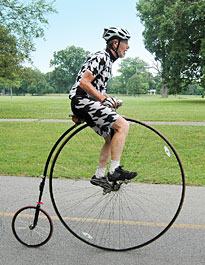 Houndstooth Racer - 2013
Houndstooth Racer - 2013
| HOME | EVENTS | PHOTOS | LINKS |